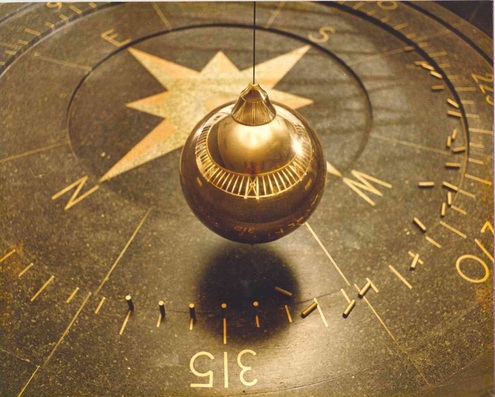Blame Google's Doodle for today's post!
I'm not a huge fan of physics, but Foucault's name is vaguely familiar to me. So, when I saw his pendulum doodle, I felt the sudden urge to know more about him (perhaps again!).
He was a French physicist made famous for his demonstration of the "Foucault pendulum", a device that can demonstrate the effect of Earth's rotation. He is also credited for making an early measurement of the speed of light, discovering eddy currents, and naming the gyroscope (although he did not invent it). Before turning to physics, though, he studied medicine, but dropped out because of blood phobia. After that, he worked on improving Daguerre's photographic processes.
His pendulum is considered a simple device that allows a demonstration of Earth's rotation. Back in those days, people already knew about this phenomena, but they had not proved it with an easy-to-see experiment.
The first exhibition of a "Foucault pendulum" took place in 1851 in the Meridian of the Paris Observatory. A few weeks later Foucault made his most famous pendulum when he suspended a 28 kg brass-coated lead bob with a 67 metre long wire from the dome of the Panthéon, also in Paris. The plane of the pendulum's swing rotated clockwise 11° per hour, making a full circle in 32.7 hours.
The basic experimental apparatus consists of a tall pendulum free to swing in any vertical plane. The actual plane of swing appears to rotate relative to the Earth. The wire needs to be as long as possible (lengths of 12-30m are common). At either the North Pole or South Pole, the plane of oscillation of a pendulum remains fixed relative to the distant masses of the Universe while Earth rotates underneath it, taking one sidereal day to complete a rotation. So, relative to Earth, the plane of oscillation of a pendulum at the North Pole undergoes a full clockwise rotation during one day; a pendulum at the South Pole rotates counterclockwise.
A "Foucault pendulum" requires care to set up because imprecise construction can cause additional veering which masks the desired terrestrial effect. The initial launch of the pendulum is critical and, traditionally, it is used a flame to burn through a thread which temporarily holds the bob in its starting position, thus avoiding unwanted sideways motion. Air resistance damps the oscillation, so some pendulums in museums incorporate an electromagnetic to keep the bob swinging; others are restarted regularly, sometimes with a launching ceremony as an added attraction.
A "pendulum day" is the time needed for the plane of a freely suspended "Foucault pendulum" to complete an apparent rotation about the local vertical. This is one sidereal day divided by the sine of the latitude.
I'm not a huge fan of physics, but Foucault's name is vaguely familiar to me. So, when I saw his pendulum doodle, I felt the sudden urge to know more about him (perhaps again!).
He was a French physicist made famous for his demonstration of the "Foucault pendulum", a device that can demonstrate the effect of Earth's rotation. He is also credited for making an early measurement of the speed of light, discovering eddy currents, and naming the gyroscope (although he did not invent it). Before turning to physics, though, he studied medicine, but dropped out because of blood phobia. After that, he worked on improving Daguerre's photographic processes.
His pendulum is considered a simple device that allows a demonstration of Earth's rotation. Back in those days, people already knew about this phenomena, but they had not proved it with an easy-to-see experiment.
The first exhibition of a "Foucault pendulum" took place in 1851 in the Meridian of the Paris Observatory. A few weeks later Foucault made his most famous pendulum when he suspended a 28 kg brass-coated lead bob with a 67 metre long wire from the dome of the Panthéon, also in Paris. The plane of the pendulum's swing rotated clockwise 11° per hour, making a full circle in 32.7 hours.
The basic experimental apparatus consists of a tall pendulum free to swing in any vertical plane. The actual plane of swing appears to rotate relative to the Earth. The wire needs to be as long as possible (lengths of 12-30m are common). At either the North Pole or South Pole, the plane of oscillation of a pendulum remains fixed relative to the distant masses of the Universe while Earth rotates underneath it, taking one sidereal day to complete a rotation. So, relative to Earth, the plane of oscillation of a pendulum at the North Pole undergoes a full clockwise rotation during one day; a pendulum at the South Pole rotates counterclockwise.
A "Foucault pendulum" requires care to set up because imprecise construction can cause additional veering which masks the desired terrestrial effect. The initial launch of the pendulum is critical and, traditionally, it is used a flame to burn through a thread which temporarily holds the bob in its starting position, thus avoiding unwanted sideways motion. Air resistance damps the oscillation, so some pendulums in museums incorporate an electromagnetic to keep the bob swinging; others are restarted regularly, sometimes with a launching ceremony as an added attraction.
A "pendulum day" is the time needed for the plane of a freely suspended "Foucault pendulum" to complete an apparent rotation about the local vertical. This is one sidereal day divided by the sine of the latitude.
~Ally

 RSS Feed
RSS Feed